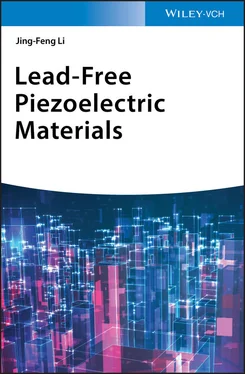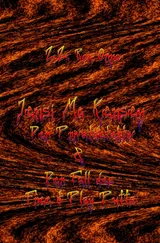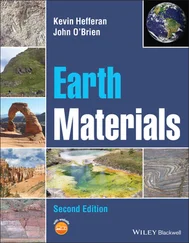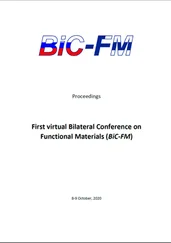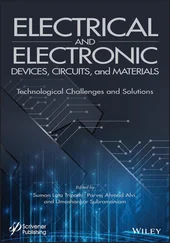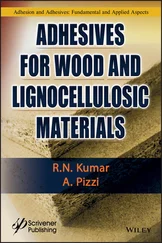Jing-Feng Li - Lead-Free Piezoelectric Materials
Здесь есть возможность читать онлайн «Jing-Feng Li - Lead-Free Piezoelectric Materials» — ознакомительный отрывок электронной книги совершенно бесплатно, а после прочтения отрывка купить полную версию. В некоторых случаях можно слушать аудио, скачать через торрент в формате fb2 и присутствует краткое содержание. Жанр: unrecognised, на английском языке. Описание произведения, (предисловие) а так же отзывы посетителей доступны на портале библиотеки ЛибКат.
- Название:Lead-Free Piezoelectric Materials
- Автор:
- Жанр:
- Год:неизвестен
- ISBN:нет данных
- Рейтинг книги:5 / 5. Голосов: 1
-
Избранное:Добавить в избранное
- Отзывы:
-
Ваша оценка:
- 100
- 1
- 2
- 3
- 4
- 5
Lead-Free Piezoelectric Materials: краткое содержание, описание и аннотация
Предлагаем к чтению аннотацию, описание, краткое содержание или предисловие (зависит от того, что написал сам автор книги «Lead-Free Piezoelectric Materials»). Если вы не нашли необходимую информацию о книге — напишите в комментариях, мы постараемся отыскать её.
Lead-Free Piezoelectric Materials
Lead-Free Piezoelectric Materials
Lead-Free Piezoelectric Materials — читать онлайн ознакомительный отрывок
Ниже представлен текст книги, разбитый по страницам. Система сохранения места последней прочитанной страницы, позволяет с удобством читать онлайн бесплатно книгу «Lead-Free Piezoelectric Materials», без необходимости каждый раз заново искать на чём Вы остановились. Поставьте закладку, и сможете в любой момент перейти на страницу, на которой закончили чтение.
Интервал:
Закладка:
Writing a book especially in foreign language is not easy, which requires not only extensive knowledge about the field but also hard work and perseverance. Prof. Jing‐Feng Li has spent more than two years to complete this monograph about lead‐free piezoelectric materials, which adds his contributions to the field of ferroelectrics and piezoelectrics. This book has systematically compiled the research progress of several promising lead‐free piezoelectric systems, which could synchronize the perspectives of researchers from both academia and industry over the development of lead‐free piezoelectric systems, and will undoubtedly inspire future research endeavors in both fundamental and application‐oriented studies.
Owing to the increasing emphasis and requirement of green manufacturing and environmental friendly materials, study on the lead‐free piezoelectric ceramics has become more popular around the world. Many significant results and findings of theoretical and experimental studies related to lead‐free piezoelectric ceramics have been published. This book has captured some of the latest developments and most recent advancements in this exciting field. I hope and believe that readers will find interesting and useful information from this book.
Longtu Li
Professor, Tsinghua University
Member of Chinese Academy of Engineering
Foreword by Professor Jürgen Rödel
Piezoelectricity allows the generation of electrical charges on the surface of certain insulating materials in response to applied mechanical stress or, conversely, allows the generation of mechanical strain when subjected to an applied electric field. With such functionality, piezoelectric materials have been increasingly used nowadays in a wide range of technologies, as an intermediary between mechanical and electric energies. Typical examples include piezoelectric sensors and actuators in smartphones, piezoelectric probes in ultrasonic diagnostic machines, piezoelectric buzzers in industrial machines, and consumer electronics including toys, high‐precision positioning units in scientific research equipment, ignitors for lighters, pressure sensors, and so on. PbZrO 3–PbTiO 3solid solutions have formed a major commercial system, abbreviated as PZT. The PZT‐based ceramics have dominated the market for about 70 years because of their excellent piezoelectric properties and a mature understanding of the processing technique. However, this “king” of piezoceramics has been challenged by the awareness of environmental protection, as European Union (EU) issued legislation on the restriction of hazardous substances (RoHS) in electrical and electronic equipment at the beginning of this century. RoHs and many other similar legislations throughout the world have stimulated the research searching for high‐performance lead‐free piezoceramics.
Significant progress has been witnessed in the past two decades. For select applications, replacements for PZT are being made available and some new materials even have advantages to PZT. For example, some of them feature higher fracture toughness, higher thermal conductivity, or simply lower density. However, transition into application demands from companies to run two production lines, one for PZT and one for the new material and customers need to be convinced. At present, there is no single system that can fully replace PZT. Nevertheless, there are competitive lead‐free substitutions, such as (K,Na)NbO 3(KNN), (Bi 0.5Na 0.5)TiO 3(BNT), and BaTiO 3‐based (BT) systems. Prof. Jing‐Feng Li has been working mainly on the KNN system, while my group is working on the BNT system. Interestingly, both systems have complementary piezoelectric properties: KNN‐based ceramics possess high quasi‐static or small‐signal piezoelectric coefficients, whereas large piezoelectric strains can be achieved in BNT‐based ceramics. For many years, we had intimate collaborations on research projects and academic exchange. I would like to mention how amazing our collaborations are, especially once we both worked as guest co‐editors for a special issue about lead‐free piezoelectrics in MRS Bulletin in August 2018.
I am very pleased to know that Prof. Jing‐Feng Li has completed the writing of a specialized book on lead‐free piezoelectric materials, which is truly a tough yet important task for our community. This comes at exactly the right time where first high‐volume applications are expected in the next three years. I noticed that this book has two introductory chapters about the fundamentals of piezoelectricity and lead‐free piezoelectrics. I particularly like the detailed descriptions on measurement technology, which is so important to newcomers into this field. The second chapter gives an overview of the lead‐free piezoelectrics, including the background, the general classification, and the research progress of the lead‐free piezoelectrics. These two chapters should be very helpful for young researchers who have just started working on research topics related to ferroelectrics and piezoelectrics. Four representative lead‐free piezoelectric systems are introduced in the later chapters, which are then followed by a final chapter about lead‐free piezoelectric applications. Such an arrangement is excellent. Explanations are clear, diagram and sketches are simple but insightful, and references are well‐chosen and complete.
This book is not meant as a stand‐alone. Scientists and engineers need to consider a basic book on ferroelectrics for all the fundamental physics and possibly a book on applications. However, this book by Jing‐Feng Li is a definite must‐read for graduate students and young researchers working on the research topics related to lead‐free ferroelectric and piezoelectric materials. It suffices both as an introduction to the field as well as the first application‐oriented book on piezoceramics. This work should also be a valuable reference for the industry who wishes to obtain a comprehensive picture of the development status of lead‐free piezoceramics.
Jürgen Rödel
Professor, Department of Materials and Earth Sciences,
Technical University of Darmstadt, Germany
Guest Professor at Tsinghua University and Tokyo Institute of Technology
Member of German National Academy of Science and Engineering
Preface
Ferroelectric/piezoelectric materials have been a hot research topic for a diversity of fields not only due to their wide applications but also because of their fascinating physical and chemical nature. The market has been dominated by lead zirconate titanate (PZT) ceramics over decades, due to their excellent properties and flexibility in terms of compositional modifications. Since 2006, the European Union has already adopted some well‐known directives, e.g. the Waste Electrical and Electronic Equipment (WEEE) directive and the Restriction of the use of certain Hazardous Substances (RoHS) in electrical and electronic equipment directive, to protect human health and the environment by prohibiting the uses of hazardous substances in electrical and electronic devices. Therefore, lead‐free piezoelectrics have been attracting more and more interest since the beginning of the twenty‐first century. Encouraging progress in the development of high‐performance lead‐free piezoelectrics has been witnessed over the last decade. Despite a very limited scale, lead‐free piezoelectric ceramics have successfully entered the market, which is estimated to be US$ 172 million in 2019. Given the significant R&D progress of lead‐free piezoelectrics, a renewal of the RoHS directive to terminate the exemption of lead‐containing piezoelectric materials should be approaching soon, at least for some applications that do not require a comprehensively excellent performance of high piezoelectricity and good temperature stability, equivalent to those of the PZT‐based materials.
Читать дальшеИнтервал:
Закладка:
Похожие книги на «Lead-Free Piezoelectric Materials»
Представляем Вашему вниманию похожие книги на «Lead-Free Piezoelectric Materials» списком для выбора. Мы отобрали схожую по названию и смыслу литературу в надежде предоставить читателям больше вариантов отыскать новые, интересные, ещё непрочитанные произведения.
Обсуждение, отзывы о книге «Lead-Free Piezoelectric Materials» и просто собственные мнения читателей. Оставьте ваши комментарии, напишите, что Вы думаете о произведении, его смысле или главных героях. Укажите что конкретно понравилось, а что нет, и почему Вы так считаете.
